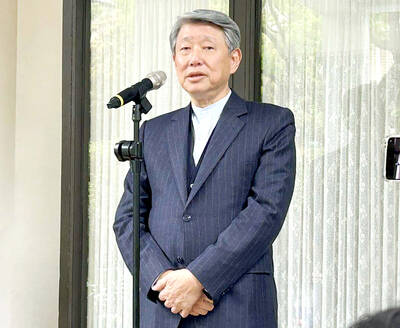China’s manufacturing activity contracted last month, official figures showed yesterday, due to tapering global demand and slow domestic recovery after curbs related to the COVID-19 pandemic were lifted.
The official manufacturing purchasing managers’ index (PMI) — a key gauge of Chinese factory output — fell unexpectedly to 49.2 from 51.9 in March, and below the 50-point mark that separates expansion and contraction in activity, Chinese National Bureau of Statistics data showed.
Analysts polled by Bloomberg expected factory activity for last month to register at 51.4.

Photo: AP
The drop comes after February recorded the highest reading in more than a decade as factories returned to normal following a surge in COVID-19 cases.
China’s economy grew 4.5 percent in the first three months of the year as the country reopened after dropping strict health controls that helped keep the virus in check, but battered businesses and supply chains.
However, the world’s second-largest economy is also beset by a series of other crises, from a debt-laden property sector to flagging consumer confidence, global inflation, the threat of recession elsewhere and geopolitical tensions with the US.
The official non-manufacturing PMI, which measures growth in the services and construction sectors, fell to 56.4 from 58.2 in March.
The March reading was the highest since May 2011, as the country saw a surge in demand for travel, entertainment and other leisure services unavailable for nearly three years during the pandemic.
The government has set a comparatively modest growth target of about 5 percent this year, a goal Chinese Premier Li Qiang (李強) has said could be hard to achieve.
The Chinese Communist Party’s top policymaking body said in a statement on Friday that the economy faces headwinds from weak demand at home and the slow pace of reforms.
“China’s economy is mainly in the process of recovering, with [internal] driving forces still weak and demand insufficient,” the politburo said, as cited by the state-run Xinhua News Agency. “Economic transition and upgrading face new headwinds, and hardships... are still to be overcome to promote high-quality development.”
Beijing has promised further state support for the private sector, which is reeling from a regulatory crackdown on the property, technology and private education industries.
Policymakers are also looking for ways to push up domestic demand, as China’s export and manufacturing sectors struggle amid tepid global demand.
One bright spot in recent months has been households spending piled-up savings on travel.
Bookings for air and train tickets and hotel reservations for the five-day Labor Day holiday starting on Saturday all surpassed the levels recorded in the same period in 2019, before the pandemic hit, according to online Chinese travel agency Fliggy (飛豬).
“China’s service sector continues to grow strongly while the manufacturing sector shows signs of weakening,” Pinpoint Asset Management Ltd (保銀私募基金管理) chief economist Zhang Zhiwei (張智威) said.
“These mixed signals will likely keep the pressure on the government to continue its supportive fiscal and monetary policies in the second quarter,” he said.

MULTIFACETED: A task force has analyzed possible scenarios and created responses to assist domestic industries in dealing with US tariffs, the economics minister said The Executive Yuan is tomorrow to announce countermeasures to US President Donald Trump’s planned reciprocal tariffs, although the details of the plan would not be made public until Monday next week, Minister of Economic Affairs J.W. Kuo (郭智輝) said yesterday. The Cabinet established an economic and trade task force in November last year to deal with US trade and tariff related issues, Kuo told reporters outside the legislature in Taipei. The task force has been analyzing and evaluating all kinds of scenarios to identify suitable responses and determine how best to assist domestic industries in managing the effects of Trump’s tariffs, he

TIGHT-LIPPED: UMC said it had no merger plans at the moment, after Nikkei Asia reported that the firm and GlobalFoundries were considering restarting merger talks United Microelectronics Corp (UMC, 聯電), the world’s No. 4 contract chipmaker, yesterday launched a new US$5 billion 12-inch chip factory in Singapore as part of its latest effort to diversify its manufacturing footprint amid growing geopolitical risks. The new factory, adjacent to UMC’s existing Singapore fab in the Pasir Res Wafer Fab Park, is scheduled to enter volume production next year, utilizing mature 22-nanometer and 28-nanometer process technologies, UMC said in a statement. The company plans to invest US$5 billion during the first phase of the new fab, which would have an installed capacity of 30,000 12-inch wafers per month, it said. The

Taiwan’s official purchasing managers’ index (PMI) last month rose 0.2 percentage points to 54.2, in a second consecutive month of expansion, thanks to front-loading demand intended to avoid potential US tariff hikes, the Chung-Hua Institution for Economic Research (CIER, 中華經濟研究院) said yesterday. While short-term demand appeared robust, uncertainties rose due to US President Donald Trump’s unpredictable trade policy, CIER president Lien Hsien-ming (連賢明) told a news conference in Taipei. Taiwan’s economy this year would be characterized by high-level fluctuations and the volatility would be wilder than most expect, Lien said Demand for electronics, particularly semiconductors, continues to benefit from US technology giants’ effort

‘SWASTICAR’: Tesla CEO Elon Musk’s close association with Donald Trump has prompted opponents to brand him a ‘Nazi’ and resulted in a dramatic drop in sales Demonstrators descended on Tesla Inc dealerships across the US, and in Europe and Canada on Saturday to protest company chief Elon Musk, who has amassed extraordinary power as a top adviser to US President Donald Trump. Waving signs with messages such as “Musk is stealing our money” and “Reclaim our country,” the protests largely took place peacefully following fiery episodes of vandalism on Tesla vehicles, dealerships and other facilities in recent weeks that US officials have denounced as terrorism. Hundreds rallied on Saturday outside the Tesla dealership in Manhattan. Some blasted Musk, the world’s richest man, while others demanded the shuttering of his